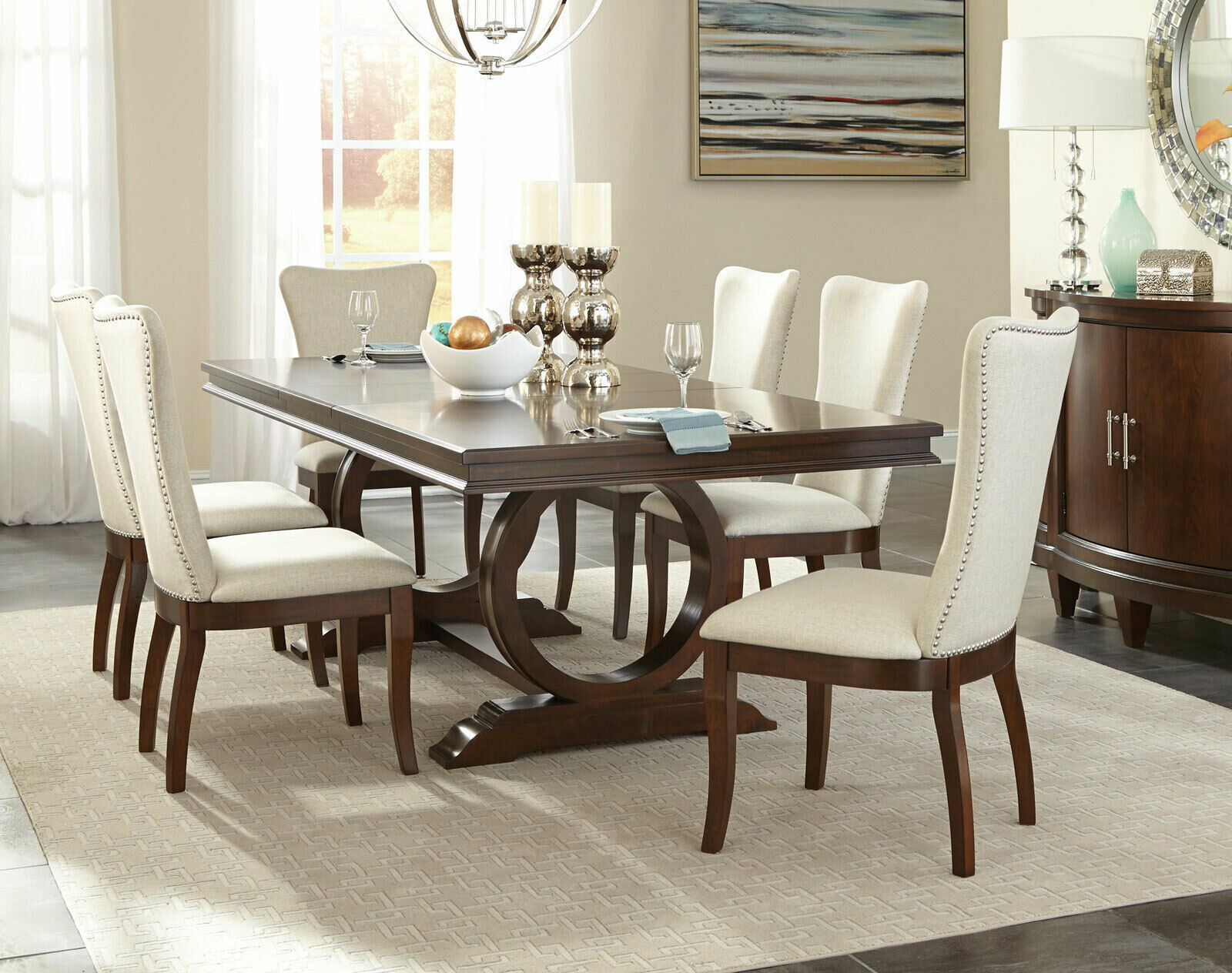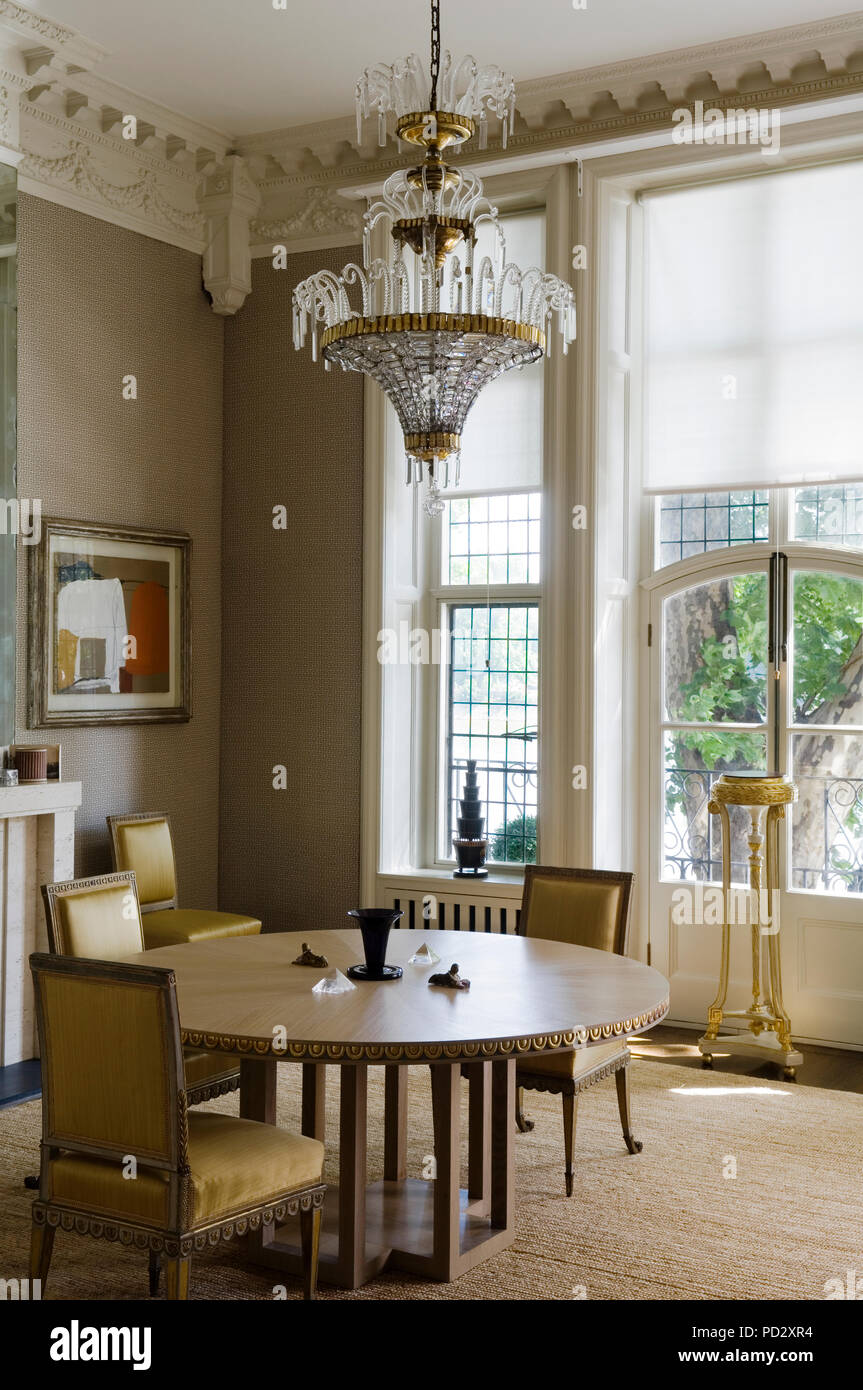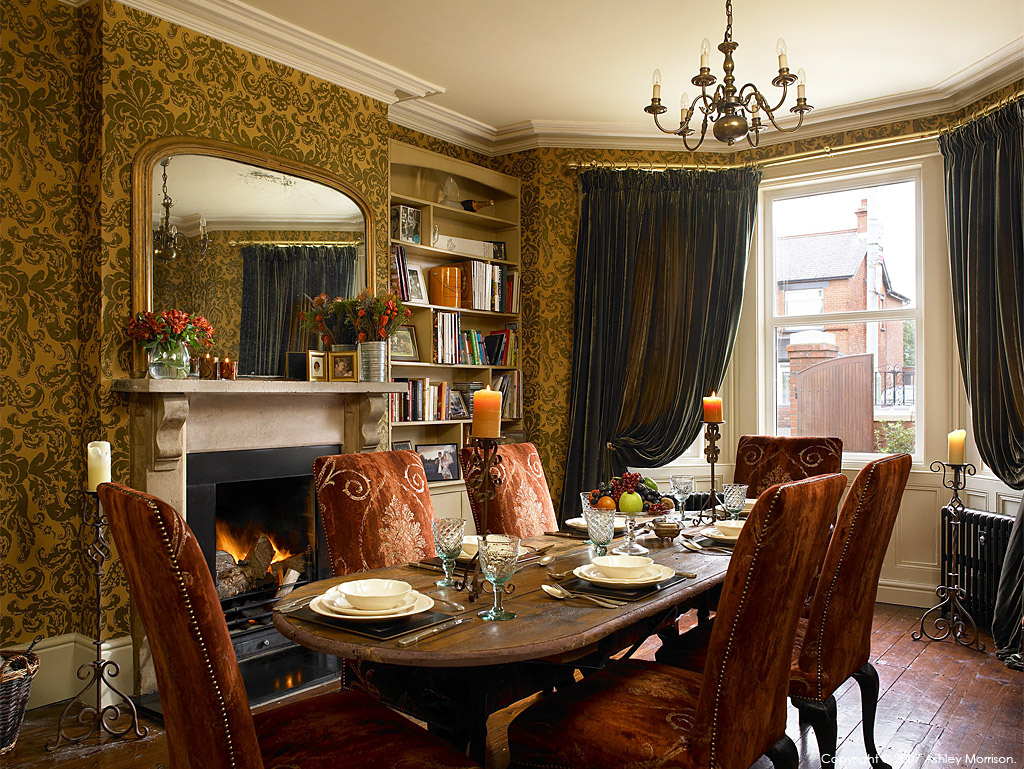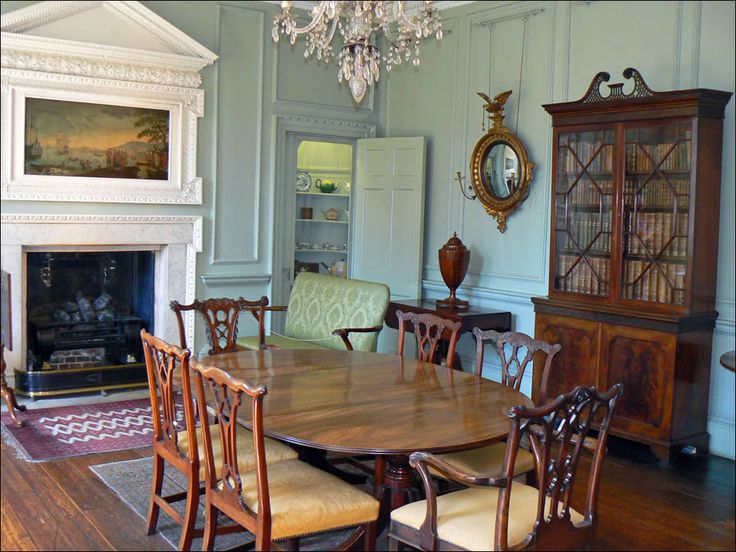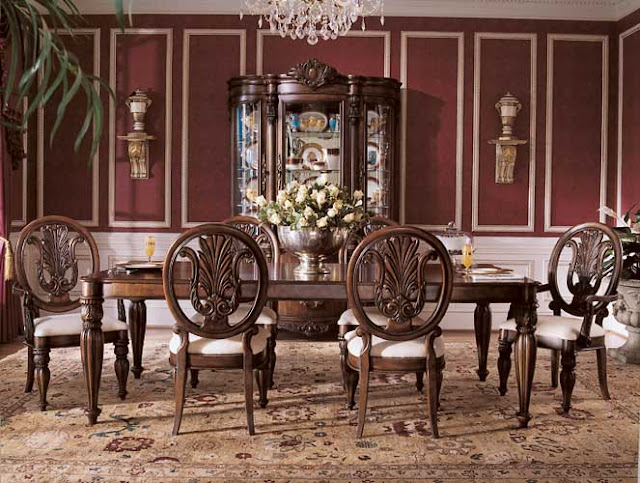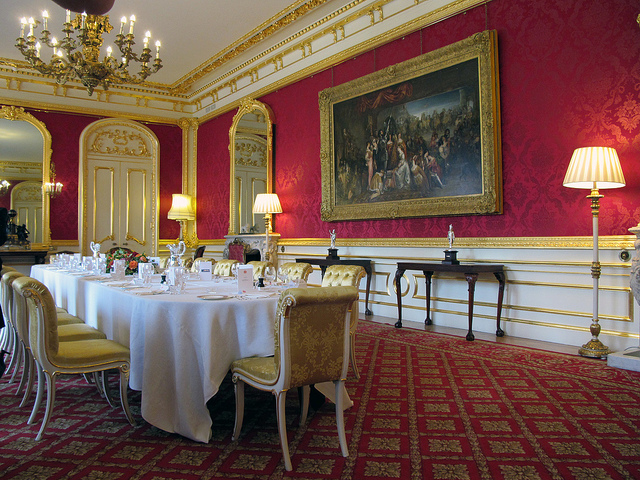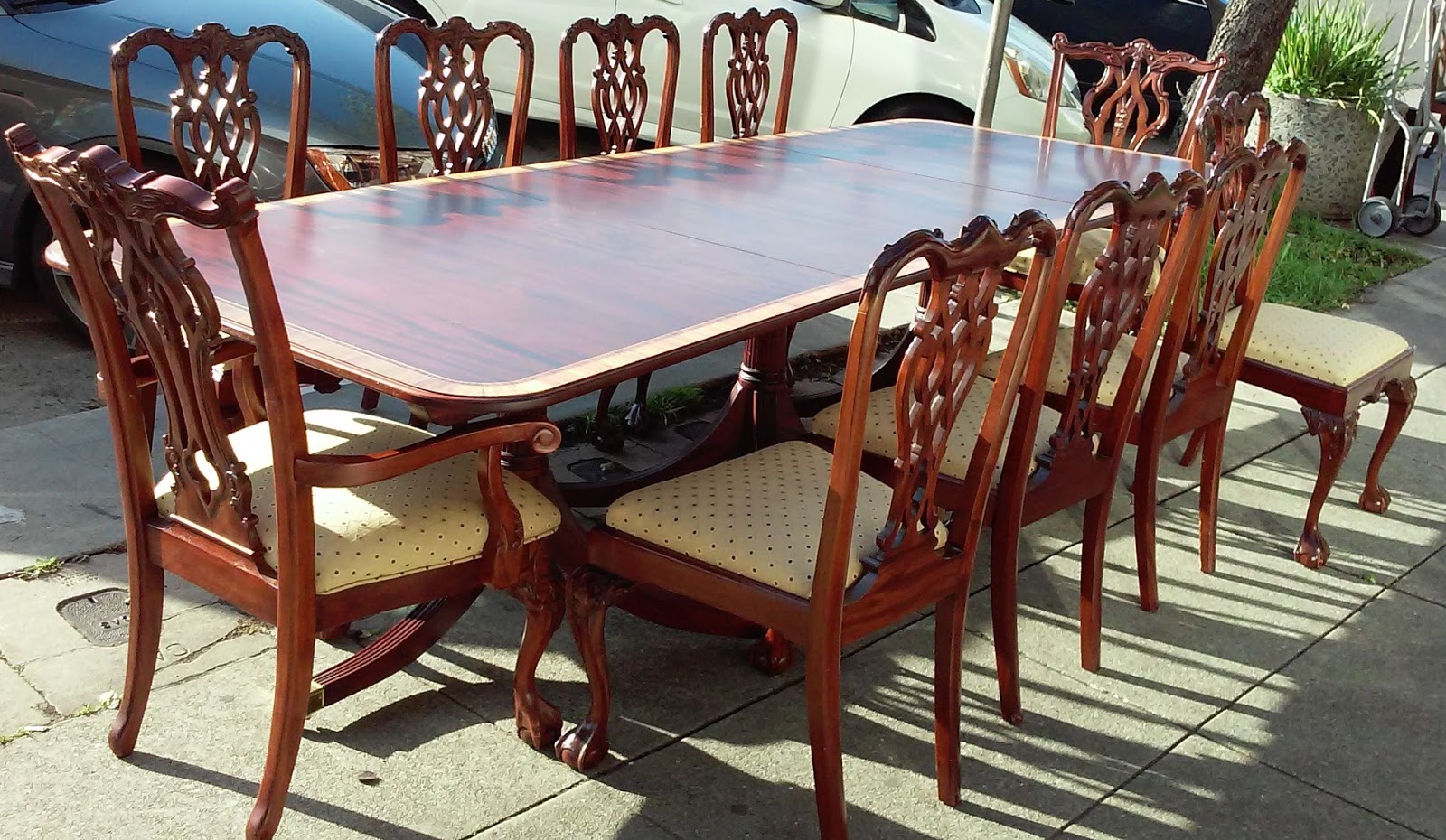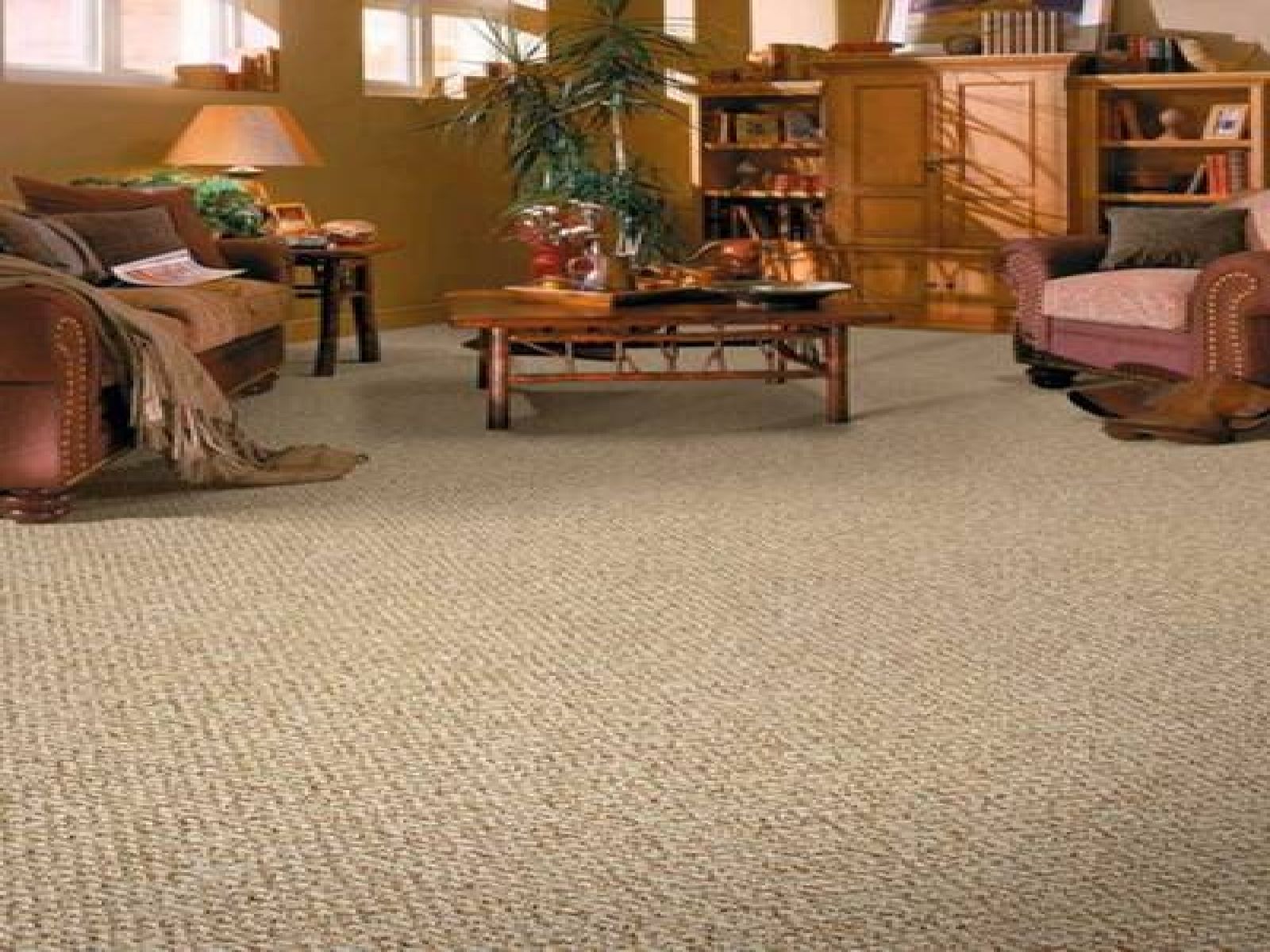Art Deco Dining Room
The Art Deco style was popularized in the 1920s and 1930s and is characterized by its sleek, geometric designs and luxurious materials. A dining room designed in the Art Deco style would feature clean lines, bold colors, and opulent details.
One of the key features of an Art Deco dining room is the use of bold, geometric patterns. This can be seen in the flooring, wallpaper, or upholstery. These patterns often incorporate stylized floral or geometric motifs and are typically in contrasting colors such as black and white or metallics.
The furniture in an Art Deco dining room is typically sleek and elegant, with streamlined shapes and ornate details. A popular choice for a dining table in this style is an antique dining table made from dark wood with geometric inlays. This adds a touch of luxury and sophistication to the room.
Complementing the dining table, vintage dining chairs in luxurious fabrics such as velvet or leather can add a touch of glamour to the room. The chairs may feature curved lines and ornate details, adding to the overall opulence of the space.
Antique Dining Table
For a more traditional and elegant dining room, an antique dining table is a must-have. A beautifully crafted wooden table with carved details can serve as the centerpiece of the room and add a touch of old-world charm.
When choosing an antique dining table, it's important to consider the style and period of the piece. A Victorian or Edwardian dining table with ornate details and curved legs would be perfect for a formal dining room, while a Federal or Chippendale style table with straight lines and simple details would suit a more traditional or colonial-style dining room.
Pairing the antique dining table with vintage dining chairs in a matching or complementary style will tie the room together and create a cohesive look. These chairs can be upholstered in rich fabrics such as brocade or velvet to add a touch of elegance and luxury.
Vintage Dining Chairs
Vintage dining chairs are not only stylish and comfortable, but they also add a touch of nostalgia to any dining room. These chairs are typically made from high-quality materials such as solid wood or metal, ensuring their durability and longevity.
When choosing vintage dining chairs, consider the style and period of the room. For a mid-century modern dining room, opt for chairs with clean lines and minimalist designs. For a vintage farmhouse style, look for chairs with rustic details and distressed finishes.
To add a pop of color to the dining room, consider reupholstering the vintage chairs in bold patterns or rich colors. This will add a touch of personality and make the chairs stand out even more.
Formal Dining Room
A formal dining room is the epitome of elegance and sophistication. This type of dining room is typically reserved for special occasions and features luxurious and expensive furnishings.
In a formal dining room, the dining table is the star of the show. A large, ornate and elaborately decorated table is perfect for hosting dinner parties and impressing guests. Pair it with matching or complementary dining chairs for a cohesive look.
Other features that can add to the formality of the room include a chandelier or crystal lighting, rich and luxurious drapery, and ornate decorative accents such as vases or candleholders.
Edwardian Dining Room
The Edwardian era was known for its elegant and sophisticated style, and a dining room designed in this period would reflect that. An Edwardian dining room would feature feminine and refined details, with a focus on light colors and ornate decorative elements.
The furniture in an Edwardian dining room would typically be made from light-colored wood, such as oak or mahogany, and would feature curved lines and delicate carved details. The chairs would be upholstered in soft fabrics such as silk or chintz, adding a touch of elegance and femininity.
To complete the look of an Edwardian dining room, add delicate decorative elements such as a crystal chandelier, floral or lace tablecloth, and ornate china and silverware.
Chippendale Dining Set
The Chippendale style originated in the 18th century and is characterized by its ornate and elaborate designs. A Chippendale dining set would feature intricate carvings, curved lines, and rich wooden finishes.
The dining table in a Chippendale dining set would typically be rectangular or oval in shape and would feature ornate carvings on the legs and apron. The chairs would also have carved details and would be upholstered in luxurious fabrics such as silk or brocade.
A Chippendale dining set can add a touch of elegance and opulence to any dining room, and can be paired with rich drapery and decorative accents such as a crystal chandelier or gilded mirrors.
Mission Style Dining Room
The Mission style originated in the late 19th century and is characterized by its simple and functional designs. A Mission style dining room would feature straight lines, minimalist details, and natural materials such as wood and leather.
The dining table in a Mission style dining room would typically be made from solid wood and would have clean lines and simple details. Similarly, the chairs would be sturdy and functional, with straight and angular designs.
To add a touch of warmth and coziness to a Mission style dining room, consider adding earthy and natural accents such as a handwoven rug, handcrafted pottery, and rustic lighting fixtures.
Arts and Crafts Dining Room
The Arts and Crafts movement emerged in the late 19th century as a reaction against the mass-produced and ornate designs of the Victorian era. An Arts and Crafts dining room would feature simple and functional designs, with a focus on high-quality craftsmanship and natural materials.
The dining table in an Arts and Crafts dining room would typically be made from solid wood and would have clean lines and minimalist details. The chairs would also be made from wood and would have straight lines and simple details.
To add a touch of warmth and coziness to the dining room, consider incorporating natural accents such as handcrafted pottery, handwoven textiles, and earthy color schemes.
Colonial Revival Dining Room
The Colonial Revival style emerged in the late 19th and early 20th centuries as a nod to the traditional and classic designs of the American colonies. A Colonial Revival dining room would feature ornate and symmetrical designs, with a focus on rich wooden finishes and delicate decorative elements.
The dining table in a Colonial Revival dining room would typically be made from dark wood and would have ornate carved details. The chairs would also have carved details and would be upholstered in luxurious fabrics such as velvet or silk.
To add to the elegance and sophistication of the room, consider incorporating ornate lighting fixtures, rich drapery, and delicate decorative elements such as vases or candleholders.
Bungalow Dining Room
The Bungalow style originated in the late 19th and early 20th centuries and is characterized by its cozy and rustic designs. A Bungalow dining room would feature simple and functional designs, with a focus on natural materials and handcrafted accents.
The dining table in a Bungalow dining room would typically be made from solid wood and would have clean lines and minimalist details. The chairs would also be made from wood and would have straight lines and simple details.
The Evolution of Dining Rooms in the Early 20th Century

The Influence of Social Customs
 During the early 20th century, dining rooms were an essential part of any household. They were used for daily meals, as well as for entertaining guests. In this era, social customs and etiquette played a significant role in the design and layout of dining rooms. The dining room was seen as a reflection of one's social status and wealth, and it was important to create a formal and impressive space for hosting guests.
During the early 20th century, dining rooms were an essential part of any household. They were used for daily meals, as well as for entertaining guests. In this era, social customs and etiquette played a significant role in the design and layout of dining rooms. The dining room was seen as a reflection of one's social status and wealth, and it was important to create a formal and impressive space for hosting guests.
The Rise of Formal Dining
 At the turn of the 20th century, formal dining became increasingly popular. This was a time of prosperity and lavish entertaining, and dining rooms were designed to accommodate large groups of people. The furniture in these dining rooms was often ornate and grand, with heavy, dark wooden tables and chairs, and elaborate china cabinets. The use of
luxurious materials such as velvet and silk
was also prevalent, adding to the opulent feel of the room.
At the turn of the 20th century, formal dining became increasingly popular. This was a time of prosperity and lavish entertaining, and dining rooms were designed to accommodate large groups of people. The furniture in these dining rooms was often ornate and grand, with heavy, dark wooden tables and chairs, and elaborate china cabinets. The use of
luxurious materials such as velvet and silk
was also prevalent, adding to the opulent feel of the room.
The Influence of Art Nouveau and Art Deco
 In the early 1900s, two major design movements emerged:
Art Nouveau and Art Deco
. These styles heavily influenced the design of dining rooms during this time. Art Nouveau was characterized by curved lines and intricate details, while Art Deco featured bold geometric shapes and sleek, modern designs. Dining rooms of this era often incorporated these elements, with furniture and decor reflecting the popular styles.
In the early 1900s, two major design movements emerged:
Art Nouveau and Art Deco
. These styles heavily influenced the design of dining rooms during this time. Art Nouveau was characterized by curved lines and intricate details, while Art Deco featured bold geometric shapes and sleek, modern designs. Dining rooms of this era often incorporated these elements, with furniture and decor reflecting the popular styles.
The Rise of the Bungalow
/cdn.vox-cdn.com/uploads/chorus_image/image/66127058/Dining_Room_0719_Beck_8.30.183448.0.0.jpg) The early 20th century also saw the rise of the bungalow, a popular architectural style that emphasized simplicity and functionality. Bungalows often featured open floor plans, with the dining room connected to the kitchen and living areas. This allowed for a more casual and relaxed dining experience, in contrast to the formal dining rooms of the past.
Rustic and natural elements
were also commonly used in bungalow dining rooms, such as exposed wood beams and natural stone accents.
The early 20th century also saw the rise of the bungalow, a popular architectural style that emphasized simplicity and functionality. Bungalows often featured open floor plans, with the dining room connected to the kitchen and living areas. This allowed for a more casual and relaxed dining experience, in contrast to the formal dining rooms of the past.
Rustic and natural elements
were also commonly used in bungalow dining rooms, such as exposed wood beams and natural stone accents.
The Impact of Technology
 The early 20th century also saw significant advancements in technology, which had a profound impact on the design of dining rooms.
Electricity
became more widespread, allowing for the use of electric lighting, which added a new level of comfort and convenience to dining rooms. The introduction of
indoor plumbing
also led to the inclusion of modern amenities such as indoor bathrooms and kitchen sinks, making dining rooms more functional and efficient.
The early 20th century also saw significant advancements in technology, which had a profound impact on the design of dining rooms.
Electricity
became more widespread, allowing for the use of electric lighting, which added a new level of comfort and convenience to dining rooms. The introduction of
indoor plumbing
also led to the inclusion of modern amenities such as indoor bathrooms and kitchen sinks, making dining rooms more functional and efficient.
In Conclusion
 The dining room of the early 20th century was a reflection of the social customs, design movements, and technological advancements of the time. From formal and opulent spaces to more casual and functional rooms, the dining room evolved to meet the changing needs and tastes of society. Today, the early 20th century dining room remains a source of inspiration for modern design, with its blend of traditional and modern elements.
The dining room of the early 20th century was a reflection of the social customs, design movements, and technological advancements of the time. From formal and opulent spaces to more casual and functional rooms, the dining room evolved to meet the changing needs and tastes of society. Today, the early 20th century dining room remains a source of inspiration for modern design, with its blend of traditional and modern elements.





